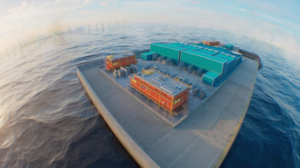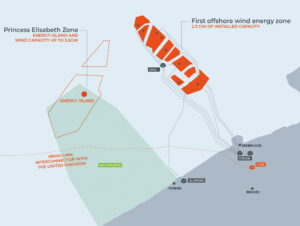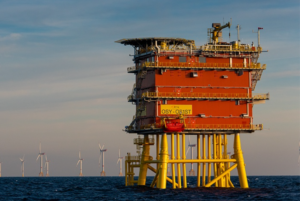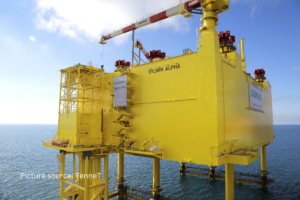World’s First Artificial Energy Island Receives Key Permit
Belgian transmission system operator (TSO) Elia has secured the environmental permit for the construction of Princess Elisabeth Island, the world’s first artificial energy island.
A consortium comprising Belgian marine construction companies DEME and Jan De Nul has already started preparing the site where it will build the caissons, or concrete foundations, in Vlissingen, the Netherlands.
Related Article
In the meantime, Elia said the company is putting the final touches on a nature-inclusive design for the island that will be submitted later this year. Together with outside experts, the design was examined to determine which items could be adjusted or added with a view to boosting biodiversity on and around the island.
Princess Elisabeth Island will be an energy hub 45 kilometres off the Belgian coast connecting new wind farms and additional interconnectors, to the UK and Denmark, to Belgium’s onshore power grid.
”Belgium is a leader in offshore wind. It is accelerating the energy transition via a fourfold increase in offshore wind capacity in the Belgian North Sea, the construction of an energy island and new interconnectors with countries which surround the North Sea,” Tinne Van der Straeten, Belgium’s Federal Minister for Energy, said.
”The energy island will become an offshore wind energy hub that will provide green, affordable energy for our families and companies. The permit that we have been granted for the Princess Elisabeth Island is another step forward in our journey of turning the North Sea into a green energy plant. It is important that we take marine life into account, both above and below water. It is good that Elia is continuing to focus on Nature Inclusive Design.”
Obtaining the permit, which Elia applied for in January 2023, is a key condition for building the world’s first artificial energy island in the North Sea, the TSO said.
Construction Starting in March 2024
The construction of the island will take around two years and is expected to last from March 2024 to August 2026.
”We plan to continue developing the North Sea as Belgium’s leading energy centre and Princess Elisabeth Island will be a crucial part of this process,” Vincent Van Quickenborne, Belgium’s Deputy Prime Minister and Minister for Justice and the North Sea, said.
”With this environmental permit, we are now taking a major step forward in developing the Princess Elisabeth Zone, our second offshore wind zone. The first wind turbines will commission in 2028, delivering additional offshore green energy for our families and companies. Since Belgium is also the first country in the world to install wind turbines in protected marine areas, we are delighted that Elia is fully committed to nature-inclusive design – further evidence of the power of taking an innovative approach, the potential of renewable energy and the importance of protecting our marine environment.”
In late June 2023, an environmental permit was granted for the construction of caissons on the premises of Verbrugge Zeeland Terminals at Bijleveldhaven, a location in North Sea Port where the 23 concrete caissons will be built, launched, stored and, in the summers of 2024 and 2025, towed to the offshore location and immersed. Afterwards, the island will be sand fill reclaimed and prepared for the construction of the high-voltage electrical infrastructure.
Whilst the construction work is being undertaken in Vlissingen, the Princess Elisabeth Island project will be coordinated from Port Oostend. Project logistics and engineering activities will be moved over to the newly renovated Stapelhuis warehouse in early November 2023. More specifically, around 80 jobs will be involved.
”North Sea Port is keen to contribute to Europe’s energy transition, together with Elia, DEME and Jan De Nul. By expanding international high-voltage connections and incorporating 3 ever-increasing amounts of renewable power, Elia is promoting both the integration of the European energy market and the decarbonisation of society. This project has further strengthened our long-term collaboration,” Daan Schalck, CEO North Sea Port, said.
Princess Elisabeth Island will be the first artificial energy island in the world to combine both direct current (HVDC) and alternating current (HVAC). The high-voltage infrastructure on the island will bundle together the export cables from the wind farms in the new Princess Elisabeth Zone while also serving as a hub for future interconnectors with the United Kingdom (Nautilus) and Denmark (TritonLink).
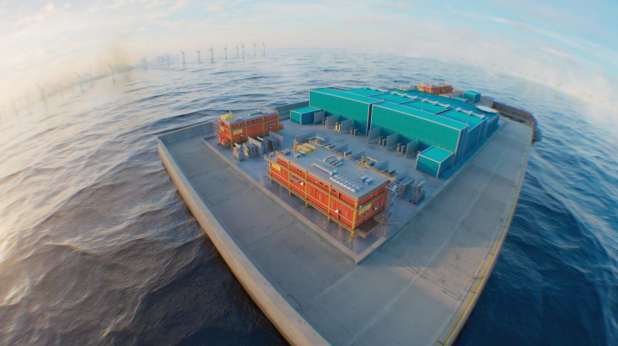
In fact, these ‘hybrid’ interconnectors will have two functions, leading to enhanced efficiency, Elia said. Not only will they handle power exchanges between countries, but they will also be connected to new offshore wind farms in the North Sea that will eventually supply Belgium with large quantities of renewable energy.
Covering six hectares, in the middle of the Princess Elisabeth Zone, Princess Elisabeth Island will be built on concrete caissons filled with sand. The island will house almost exclusively transmission infrastructure used to connect new wind farms of up to 3.5 GW capacity, as well as future interconnectors. There will also be a small harbour for maintenance crews and a helideck. Some 300 kilometres of alternating current cables (HVAC) and 60 kilometres of direct current cables (HVDC) will be installed around the island to connect all future offshore facilities to the Belgian high-voltage grid.

ADVERTISE ON OFFSHOREWIND.BIZ
Get in front of your target audience in one move! OffshoreWIND.biz is read by thousands of offshore wind professionals daily.
Follow offshoreWIND.biz on:

